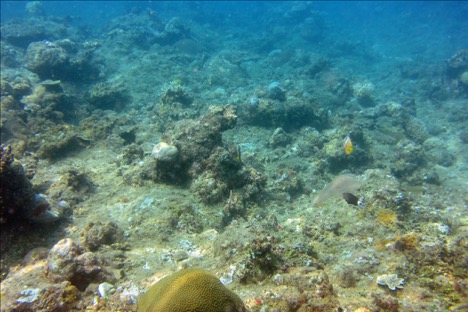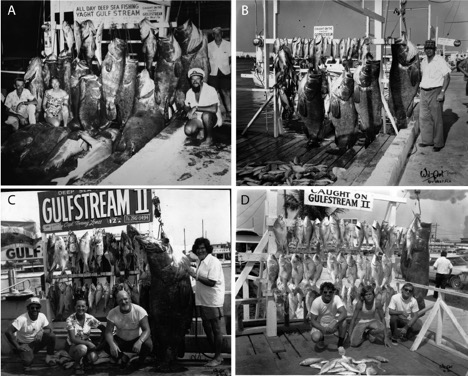Coral Reefs: The End of the Line?
For a long time, people beyond the tropics knew nothing of coral reefs. Terrestrial ecosystems have been studied for hundreds of years, but modern marine science didn’t exist until the nineteenth century. And coral reefs were not really explored by scientists until the 1950s, when Jacques Cousteau’s camera and the newly invented regulator gave birth to SCUBA diving. By this point, coral polyps like the ones we know today had been building and rebuilding limestone skeletons and supporting marine life for 200 million years.[i]
When coral reefs finally came to the attention of the European and American scientific communities, the initial reports described wonders that would astonish most recreational divers of 2016. Groupers as long as men were nothing special in the Caribbean in 1900. So many sharks swarmed the waters that they’re not even mentioned except as a nuisance. Many accounts describe 100 percent live coral cover in a rainbow of different shades.[ii]
Imagine your first dive. Unless you were lucky enough to learn in the Maldives or another far-flung tiny island, finding “Nemo” was probably the high point of your excursion- and you loved it! That’s one of the perception problems in marine conservation; being underwater and seeing some creatures is so cool (and unfamiliar) that new divers don’t recognize the lack of big fish or plentiful coral as damage. But if damage is already present at a site dive-able enough to enjoy, what about the sites where tourists don’t go? What most recreational divers don’t realize is how many, many, many reefs worldwide are now almost or already destroyed.
Take the Philippines archipelago as an example. This country’s 7,107 islands hold 36,289 kilometers of coastline with 25,060 square kilometers of coral reef.[iii] Yet the main tourist dive sites sit on only a few hundred square kilometers. Even with new dive sites yet to be discovered, there are many more places that visitors will never go, because (excepting the rare hidden jewel) most reefs are no longer dive-able. A 2004 study found that only 6% of Philippines reefs had “excellent” or “good” live coral cover, while the other 94% percent had live coral on less than half of their surface area (“fair” to “poor”).[iv]
What do reefs with “fair” and “poor” live coral cover look like? It depends on what damaged them. For the most part, they lack color (live coral is a hundred shades of red, yellow, purple, you name it…), and they lack fish. (Small-scale Philippines fisherfolk now catch an average of 3 kilograms per day, in contrast with 40 kilograms per day in 1940.[v]) If the damage was caused by overfishing, sedimentation (from deforestation), nutrient overload (from sewage or fertilizers), or bleaching-induced mortality (from climate change), the once-living corals will be covered in algae and sometimes silt. If the reef was blown apart by dynamite fishing, it will look like a field of broken bones- fragments of calcium carbonate skeletons not unlike our own. Obviously, dive tours don’t go to these areas. But you’re being hoodwinked if you think that coral reefs generally look like the places your dive guide takes you to see.
It would be nice to think such damage is limited to a few countries. And of course, the state of reefs differs from place to place. However, scientists from around the world have coordinated a global monitoring program, and the results are overwhelmingly negative. The 2011 report from the Global Coral Reef Monitoring Network[vi], states that over 60% of Earth’s reefs are threatened by human impacts (as in, on their way to destruction if those impacts continue), and if climate change is included, the percentage jumps to 75%[vii]. Based on Australia’s ongoing bleaching event in the Great Barrier Reef, climate change should indeed be included.
It would also be nice to think that we will manage to reverse these trends. Unfortunately, unsustainable greenhouse gas emissions continue, along with negatively impactful coastal development, irresponsible and damaging commercial (or small-scale) fisheries, needless slaughter like the shark fin trade, and deforestation for lumber, agriculture, and homes. While small-scale success stories have inspired more and more small-scale initiatives, the larger trend continues downward.
How does that impact you? You’ll really have to search for a place where, through lucky environmental conditions and good local management, you can have a great dive. Think about how much more impacted local communities will be (and already are). Many of the people who live along the thousands of kilometers of degraded reef which tourists don’t see get an estimated half of their protein from sea food[viii], and hover at the poverty line. If you fell in love with coral reefs through diving, and vice versa, consider showing your gratitude by becoming an advocate: educate yourself, find a way to support conservation, and remember that the state of coral reefs impacts not only your vacation, but millions of people who depend on reefs for their lives.
[i] http://www.columbia.edu/itc/eeeb/baker/N0316/Lecture%205/page2.htm
[ii] Roberts, Callum. The Unnatural History of the Sea: The past and future of humanity and fishing. Octopus Publishing Group Ltd; London, 2007.
[iii] http://coral.unep.ch/atlaspr.htm
[iv] Nañola, C. L., A. C. Alcala, P. M. Aliño, et al. 2005. “Philippines.” In Status of Coral Reefs in East Asian Seas Region: 2004, edited by Japan Wildlife Research Center. Tokyo: Ministry of Environment.
[v] Fisherfolk using hook and line fishing gear from six provinces in the Philippines: Philippines Fisheries in Crisis.
[vi] Global Coral Reef Monitoring Network, International Coral Reef Initiative.
[vii] Burke, Lauretta, et al. “Reefs at Risk Revisited.” World Resources Institute; Washington D.C., 2011.
[viii] http://coralreefsystems.org/blog/science

Degraded Reef
Photo credit: Julia Herbolsheimer, 2015

- Strange Sharks – February 1, 2018
- Getting to know Jaws: the truth about great white sharks – October 20, 2017
- Reef Sharks: Coral’s Best Friend – September 26, 2017

 CAD
CAD